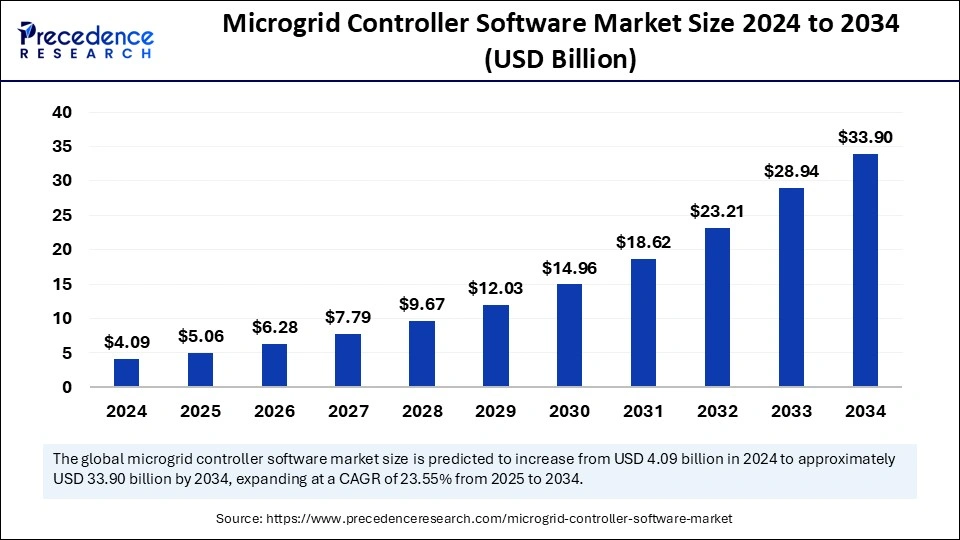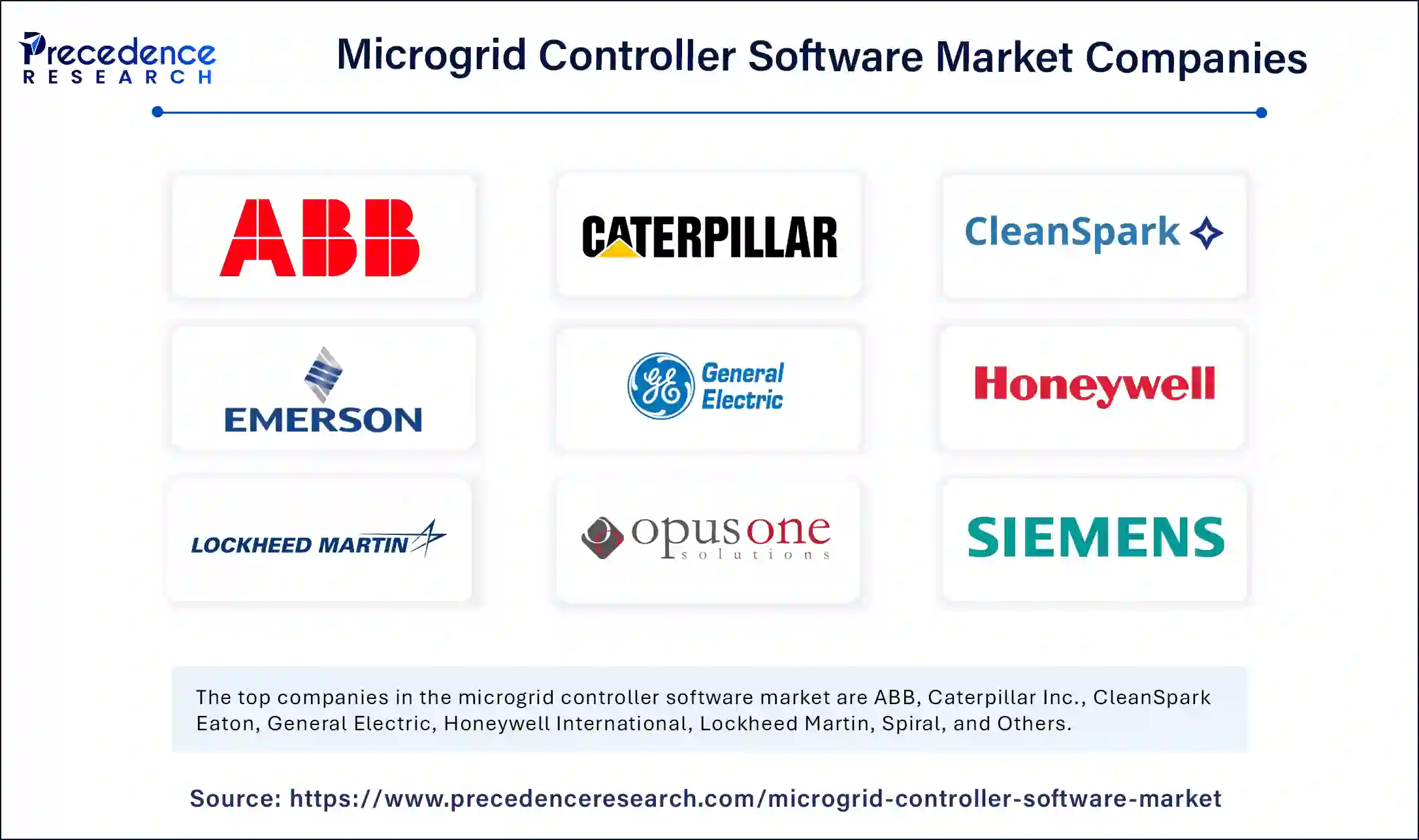Microgrid Controller Software Market Size to Surpass USD 33.90 Bn by 2034
Microgrid Controller Software Market Size and Growth
The global microgrid controller software market size is expected to surpass around USD 33.90 billion by 2034 increasing from USD 4.09 billion in 2024, with a CAGR of 23.55%.

Get a Free Sample Copy of the Report@ https://www.precedenceresearch.com/sample/5770
Microgrid Controller Software Market Key Points
-
With a 41% share, North America led the market in 2024.
-
Asia Pacific is anticipated to grow at the highest rate over the forecast period.
-
Grid-connected solutions captured 76% of the market under the connectivity segment in 2024.
-
The off-grid connected category is poised for substantial growth in the coming years.
-
Energy Management Systems (EMS) dominated the offering segment with a 46% market share in 2024.
-
Advanced Distribution Management Systems (ADMS) are expected to achieve the fastest CAGR.
-
The commercial and industrial sector contributed 37% to the market under end-use in 2024.
-
The residential sector is projected to expand at the fastest rate in the coming years.
-
Cloud-based deployment held a majority stake of 59% in 2024.
-
The on-premise segment is forecasted to grow rapidly during the projected period.
Role of AI in the Microgrid Controller Software Market
Artificial Intelligence (AI) is transforming the microgrid controller software market by enhancing efficiency, automation, and sustainability. AI-driven microgrid controllers optimize energy distribution, improve grid stability, and enable real-time decision-making, making energy systems smarter and more reliable.
One of AI’s key roles is in smart energy management, where it analyzes energy demand and supply in real time to ensure optimal energy distribution. By predicting consumption patterns, AI helps balance loads efficiently and reduces energy wastage. Additionally, AI-powered predictive maintenance and fault detection identify potential failures in microgrid components, allowing preventive maintenance and minimizing downtime.
AI also plays a crucial role in grid stability by forecasting demand fluctuations and adjusting power generation accordingly. This is especially important for integrating renewable energy sources like solar and wind, as AI can predict weather conditions and optimize power generation for maximum efficiency. Furthermore, AI-driven controllers automate decision-making based on real-time data, enabling self-adjustments to improve system performance and reduce operational disruptions.
Cybersecurity is another critical aspect where AI contributes to the microgrid controller market. AI-powered security systems detect and mitigate cyber threats by analyzing network traffic patterns and identifying suspicious activities. This ensures the safety of energy infrastructures from potential cyberattacks. Additionally, AI supports demand response programs by adjusting energy consumption based on electricity prices and grid conditions, improving resilience during power fluctuations or outages.
By optimizing energy usage and minimizing inefficiencies, AI significantly reduces operational costs. Machine learning algorithms help microgrids strategically shift energy loads and minimize reliance on expensive peak-hour electricity. As the adoption of decentralized energy systems and smart grids continues to grow, AI will play an increasingly vital role in making microgrid operations more efficient, cost-effective, and sustainable.
Growth Factors of the Microgrid Controller Software Market
The microgrid controller software market is experiencing significant growth due to the increasing demand for decentralized energy solutions and the integration of renewable energy sources. As the world transitions toward cleaner and more efficient energy systems, microgrid controllers play a crucial role in managing energy distribution, optimizing power generation, and ensuring grid stability.
One of the primary growth factors is the rising adoption of renewable energy, such as solar and wind power. Microgrid controller software helps efficiently integrate these energy sources into the grid by predicting energy fluctuations and optimizing power distribution. Additionally, the growing need for energy resilience and reliability, especially in remote areas and critical infrastructure like hospitals and military bases, is driving the demand for advanced microgrid control systems.
Technological advancements in artificial intelligence, machine learning, and IoT are further fueling market growth. AI-powered microgrid controllers enable real-time decision-making, predictive maintenance, and automated energy management, reducing operational costs and improving overall system performance. Additionally, increasing investments in smart grid infrastructure and government initiatives to promote clean energy adoption are accelerating market expansion.
The growing demand for energy independence among commercial, industrial, and residential sectors is another key driver. Businesses and communities are increasingly turning to microgrids to reduce dependency on traditional power grids, lower electricity costs, and enhance sustainability. Furthermore, advancements in cloud-based microgrid controller software offer real-time monitoring, remote management, and scalability, making microgrid solutions more accessible and efficient.
Regulatory support and incentives for microgrid deployment are also contributing to market growth. Governments worldwide are implementing policies and funding programs to encourage the adoption of microgrids for energy security and environmental benefits. As microgrid controller software continues to evolve with enhanced features and functionalities, its adoption is expected to rise, driving further market growth in the coming years.
Market Scope
| Report Coverage | Details |
| Market Size by 2034 | USD 33.90 Billion |
| Market Size in 2025 | USD 5.06 Billion |
| Market Size in 2024 | USD 4.09 Billion |
| Market Growth Rate from 2025 to 2034 | CAGR of 23.55% |
| Dominating Region | North America |
| Fastest Growing Region | Asia Pacific |
| Base Year | 2024 |
| Forecast Period | 2025 to 2034 |
| Segments Covered | Connectivity, Offering, End-use, Deployment Mode and Regions. |
| Regions Covered | North America, Europe, Asia-Pacific, Latin America, and Middle East & Africa |
Market Dynamics
Key Market Drivers
The market is primarily driven by the increasing demand for energy resilience in industries, commercial establishments, and residential communities. Government regulations supporting renewable energy adoption and the electrification of remote areas are also significant contributors. The rise of smart cities and digital transformation in the energy sector further fuel the demand for microgrid controllers.
Emerging Opportunities
Innovations in cloud-based microgrid management solutions are creating new growth opportunities. Cloud-enabled platforms allow real-time data analytics, remote monitoring, and predictive maintenance, enhancing the efficiency of microgrid operations. Additionally, microgrid expansion in military bases, healthcare facilities, and industrial parks presents substantial market potential.
Industry Challenges
A major challenge in the microgrid controller software market is the lack of standardized regulations and interoperability between different energy systems. Many microgrid deployments require customized solutions, which can complicate implementation. Moreover, high capital expenditures for installation and integration may slow adoption in certain regions.
Regional Market Performance
North America leads the market with widespread deployment of microgrids in commercial and industrial sectors. Asia Pacific is emerging as a key market, fueled by rapid infrastructure development and increasing demand for decentralized power solutions. In Europe, government-backed renewable energy projects and decarbonization initiatives are driving steady market growth.
Microgrid Controller Software Market Companies

- ABB
- Caterpillar Inc.
- CleanSpark Eaton
- Encorp Emerson commercial and residential solutions
- General Electric
- Honeywell International
- Lockheed Martin
- Ontech Electric Corporation
- Opus One Solutions
- RTSoft, Princeton Power Systems
- S&C Electric
- Schweitzer Engineering Laboratories
- Siemens
- Spiral
Leaders’ Announcements
- In January 2025, ABB and Edgecom Energy joined forces to enhance energy optimization for industrial and commercial clients through the AI-powered platform of Edgecom, highlighting the transition of the market to smart EMS solutions.
- In September 2024, Horizon Power and Siemens collaborated on a microgrid initiative in Western Australia, utilizing the advanced software of Siemens to enhance energy distribution from solar panels and battery systems for off-grid communities impacted by natural disasters.
Recent Developments
- In October 2024, Aspen Technology, Inc. introduced the AspenTech Microgrid Management System, targeting asset-heavy sectors such as refining, chemicals, and mining. The system enhances power production, storage, and load control, tackling energy needs, outdated infrastructure, and cybersecurity risks with the objective of achieving net-zero targets.
- In March 2023, Fortress Power introduced the eSpire Mini, a modular energy storage option designed for commercial and industrial applications, which connects with distributed energy resources and includes microgrid controller software.
- In February 2023, Schneider Electric acquired DERMAPOWER, enhancing its microgrid control features for commercial and industrial uses, which allows for improved energy management solutions.
Segments Covered in the Report
By Connectivity
- Grid Connected
- Off-grid Connected
By Offering
- Energy Management Systems (EMS)
- Advanced Distribution Management Systems (ADMS)
- Supervisory Control and Data Acquisition (SCADA)
- Others
By End-use
- Utility Providers
- Commercial and Industrial
- Residential
- Government and Military
- Educational Institutions
- Others
By Deployment Mode
- Cloud-Based
- On-Premise
By Geography
- North America
- Europe
- Asia Pacific
- Latin America
- Middles East and Africa
Also Read: Power Strip Market
Ready for more? Dive into the full experience on our website@ https://www.precedenceresearch.com/
